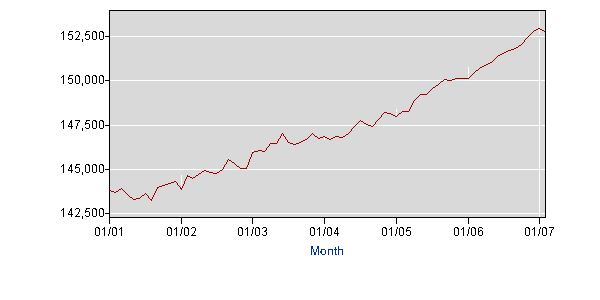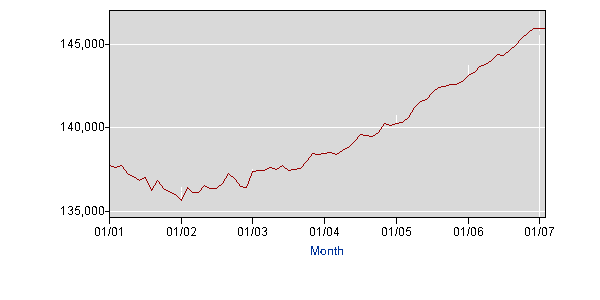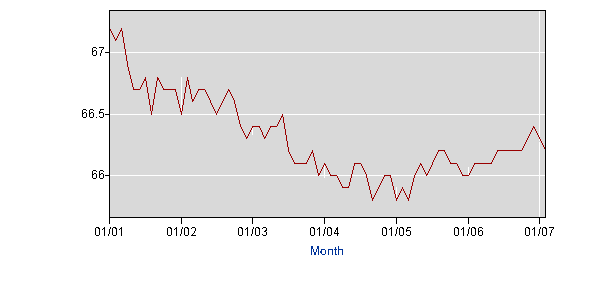Employment has continued to expand as job losses in manufacturing and residential construction have been more than offset by gains in other sectors, notably health care, leisure and hospitality, and professional and technical services, and unemployment remains low by historical standards.
He went on to note:
The continuing increases in employment, together with some pickup in real wages, have helped sustain consumer spending, which increased at a brisk pace during the second half of last year and has continued to be well maintained so far this year. Growth in consumer spending should continue to support the economic expansion in coming quarters.
In other words, job growth is very important right now because it supports consumer spending. In fact, job growth is more important in light of decreased business and residential investment in the 4th quarter of 2006.
So, let's look at the job market to see exactly where we are. All of this information is from the Bureau of Labor Statistics. In addition, I'm going to use averages. I know this is not the best statistical methodology to use, but I want to get a feel for the employment picture.
The total civilian labor force was 142,267,000 in January 2001 and 152,974,000 in January 2007. That's an increase of 10,707,000 over 6 years, or 1,784500/year or 148,708/month. Here's a graph of the growth. It's a fairly constant upward sloping line.

The total number of employed people was 137,778,000 in January 2001 and 145,957,000 in January 2007, or an increase of 8,179,000, or 1,363166/year or 113,597/month. However, this figure languished until roughly the beginning of 2004 when it increased a bit faster than population growth:

In other words, on average, the economy has created 35,111 jobs month/less than population growth since January 2001.
However, the labor participation rate has decreased over this time from 67.2% in January 2001 to 66.2% in January 2007. In other words, a smaller percentage of the labor force is working today than in January 2001. In addition, the LPR decreased from January 2001 to early 2004 when the total number of jobs in the economy also languished. This indicates the lower participation rate may have permanently removed a certain amount of people from the market, at least for the duration of this expansion. Here's a graph of the LPR:

This is why the average difference between the number of jobs created and the average increase in the total labor force isn't resulting in a higher unemployment rate. Simply put, a smaller percentage of people who could be working are in fact working.
When I labeled the job market the "just enough" job market, I was referring to the fact the market is creating just enough jobs to absorb the population that wants/can find a job/is willing to work (etc...) to work.
So long as this remains the situation, the job market should support the economy. It may prevent the housing market problems from bleeding into growth.